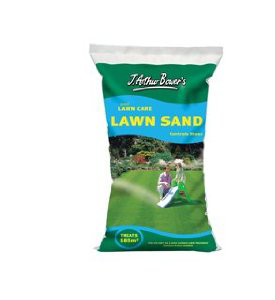


Search This Site
Search With Google
Conditions That Stimulate Moss Growth
Lawn Sand
Moisture Meter Guide
The complete moisture meter website
The reason you have, or want to have, a lawn scarifier is to remove any unwanted thatch from your lawn and deal with any moss that has taken over patches of your lawn. Another method of dealing with moss and weeds in your lawn is to use lawn sand. For as long as I can remember using lawn sand to deal with and control moss has been the traditional method.
Lawn sand contains iron sulphate which will remove the moss, ammonium sulphate which encourages and stimulates grass growth for recovery and sand which is used as the carrier. Lawn sand can be in the form of a powder or granular form. You can spread it using your hands or with a garden spreader specially designed for the job. You do this when the grass is dry and water it thoroughly afterwards if there is no rainfall due.
Moisture Meter Guide 2010 Contact details:garnett65@hotmail.com
When moss becomes a problem in your lawn you will need to take action by applying lawn sand and using a lawn scarifier. If the moss has spread rapidly you will have a bug job on your hands. So it is a good idea to familiarize yourself with the conditions that moss thrives in.
If you know these conditions then you can try to eliminate them at source. This way you will be able to manage your lawn more efficiently.
It is during the winter months that moss can be a severe problem to all types of turf and lawns. The conditions that moss thrives in are :
1-
2-
3-
4-
5-
6-
To Care Is To Share
Uses Of Lawn Sand
Lawn sand is applied to a lawn to control any lawn weeds or moss. It is made up of ammonium sulphate, iron sulphate and sand and is applied to any lawn by hand or specific spreader. It is mostly necessary for lawns that are under stress from shade, drought and water logging where weed and moss infestation is rife. As effective as it is, it should not though be used all the time. It should be incorporated as just one step in your lawn care regime. Remember , by employing a good lawn care regime you will have a healthy lawn that is less susceptible to problems such as weeds and moss.
Tips
4 days after applying thoroughly water the lawn.
3 weeks after application, rake up dead undergrowth. If weeds or moss are still present then employ a weed killer or use your lawn scarifier.
How Lawn Sand Works
For dealing with weeds and moss lawn sand has to be selective in the plants it actually destroys. Because grass leaves are different in shape and structure to weed and moss leaves the lawn sand can differentiate. When applied the lawn sand will settle on broad leaves and fibrous mass like moss. It the scorches them until they are destroyed.
Because the grass blades are fine with hardly any horizontal surface area, the lawn sand simply slides off them and falls between them in to the soil or thatch layer. The result is that the grass blades are never scorched. An additional benefit of the lawn sand is that when it reaches the soil it actually stimulated root growth and assists with the “green” effect of the lawn. So lawn sand not only protects your lawn, but it also stimulates it as well.
Application Of Lawn Sand
Using lawn sand should be limited to early Spring and again in Summer if necessary. You need to apply it on a dry day and if after a couple of days of applying it there has been no rain, then you need to water your lawn thoroughly.
Before applying lawn sand always check the lawn weeds and moss. What you want are weeds that are in mid growth. This is because you need a suitable weed leaf area for the lawn sand to settle on and do it’s job. Also before applying lawn sand never cut your lawn. You need to have at least 3 days growth of your weeds to provide a suitable base for the lawn sand to work upon. In our experience we find that if you do not cut your lawn for a week, the weeds and moss have perfect leaf areas for the lawn sand to excel.
Though more environmentally friendly than the majority of chemical lawn weed killers, you still need to take care and precautions when applying lawn sand. Always follow the manufacturers instructions for the amounts to use on your lawn. Wear good gloves if you are applying by hand, but if at all possible always use a spreader as your first choice of distributing the lawn sand.
Once you have applied the lawn sand leave it to do it’s job. Do not cut your lawn for at least 4 days. This is the minimum amount of time that the lawn sand requires to work it’s treatment. When you do eventually cut your lawn again, remember not to put the first clippings on your compost heap. They will higher levels of chemicals than normal.
A lawn is safe to use again by children and pets once the treated area has been watered.
Keep grazing animals away from a treated area for at least 4 weeks.
Never use lawn sand on a new lawn or turf that is younger than 6 months.
After using lawn sand you can reseed an area 4 weeks after-
Lawn sand can be used around trees.
Avoid letting lawn sand come in to contact with foliage.
Sulphates can stain clothing.
Always sweep up and clean the area if lawn sand is accidentally spilt.
Lawn Sand Advice
| Tramex Moisture Encounter Plus |
| Tramex Compact Wood Moisture Meter |
| Tramex Concrete Encounter Moisture Meter |
| Tramex Skipper Plus Moisture Meter |
| Tramex Roof And Wall Moisture Scanner |
| Sonin Digital Moisture Meter model 50218 |
| Sonin Digital Moisture Meter 270 model 50270 |
| Sonin Moisture Test Tool model 50210 |
| Sonin Moisture Test Meter Model 50211 |
| Oak |
| Douglas Fir |
| Beech Tree |
| Elm Tree |
| Hickory Tree |
| Maple Tree |
| Pine Tree |
| Prevent And Repair Gaps In Wooden Floorboards |
| How To Fix A Squeaky Hardwood Floor |
| How To Repair A Hardwood Floor That Has Buckled |
| Which Is The Best Firewood? |
| Concrete |
| Concrete Moisture |
| Screed Moisture Meter |
| SDS Drill |
| Belle Cement Mixer |
| SDS Drill Advice |
| Which SDS Drill |
| SDS Drill Accessories |
| Drilling Into Concrete |
| Kennedy Tool Box |
| Moisture - Basic Facts |
| Types Of Damp |
| Wet Rot |
| Dry Rot |
| Mold |
| Water Leak Detection |
| Stucco Moisture |
| Water Damage |
| Moisture And Rust |
| Moisture Damage To A Chimney |
| Wallpaper Stripper |
| Plaster Mixer |
| Why Worry About Moisture Problems |
| Does Your Home Have A Moisture Problem? |
| How To Solve Moisture Problems |
| How To Use Anti Mold Paint |
| Rising Damp |
| Condensation |
| Salt Damp |
| How To Avoid Bathroom Condensation |
| How To Remove Black Mold |
| How To Prevent Bathroom Mold |
| Soldering Kit |
| Soldering Kit Contents |
| Soldering Kit Advice |
| Bonsai Tree Classification |
| Growing Bonsai From Seed |
| Bonsai Tree Care |
| Bonsai Tree Training |
| Bonsai Tools |
| Displaying Bonsai |
| Bonsai Calendar |
| Bonsai Plants |
| The Thirsty Light Curve Moisture Meter |
| The Thirsty Light Ladybird Moisture Meter |
| The Thirsty Light Bumble Bee Moisture Meter |
| The Thirsty Light Butterfly Moisture Meter |
| Hanna Instruments |
| Agratronix Portable Coffee Moisture Tester |
| Lawn Aerator |
| Lawn Roller |
| Lawn Rake |
| Lawn Sand |
| Chainshot |
| Chainsaw Gloves |
| Chainsaw Trousers |
| Chainsaw Boots |
| Mac 4 - 20 XT Chainsaw |
| Mac 738 Chainsaw |
| Mac 842 Chainsaw |
| Mac 20X Power Chainsaw |
| Einhell BG-PC 3735 Chainsaw |
| Einhell BG-PC 4040 Chainsaw |
| Einhell BG-PC 5045 Chainsaw |
| Poulan P3314 Chainsaw |
| Poulan P4018 Chainsaw |
| Poulan Pro PP3816AV Chainsaw |
| Poulan Pro PP4218AVX Chainsaw |
| Poulan Pro PP4620AVX Chainsaw |
| Efco MT 4100 SP Chainsaw |
| Efco MT 3500 Chainsaw |
| Efco 132 S Chainsaw |
| Efco 147 Chainsaw |
| Efco 152 Chainsaw |
| Efco MT 7200 Chainsaw |
| Efco MT 8200 Chainsaw |
| Efco MT 3750 Chainsaw |
| Methods Of Obtaining Soil Moisture Levels |
| Hygrometer |
| Psychrometer |
| Rain Gauge |
| Wave Ventilation System |
| Humidity |
| Hygrometer For Keeping Reptiles |
| Humidor |
| Weather Stations |
| Musical Instrument Storage |